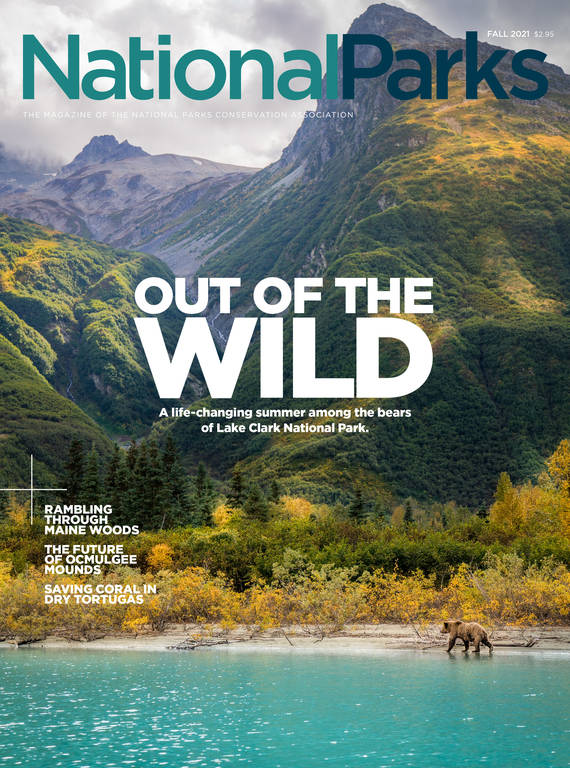Fall 2021
Whales of the Deep
Scientists are probing the depths of Northeast Canyons and Seamounts Marine National Monument to learn more about elusive beaked whales.
The small boat maneuvered within yards of a rare True’s beaked whale in the waters near Northeast Canyons and Seamounts Marine National Monument. The researchers held their breath as they tried to attach a digital tag to the animal’s back with a suction cup. Beaked whales seldom come to the surface for long, so the team’s window of opportunity was fleeting, and they had already made several attempts. If the whale dived again, they might not get another chance. Extending a long pole over the whale, they finally slapped the tag on the animal’s back, and the tag held tight. The team erupted in cheers — no one had ever successfully tagged a True’s beaked whale before.
“We had all worked so hard to get to that moment, and it was a huge accomplishment,” said Danielle Cholewiak, a research ecologist at the Northeast Fisheries Science Center and the leader of the summer 2018 expedition. “For the first time, we were going to have a little more insight into the deep, underwater behavior of this elusive species.”
Beaked whales are among the most mysterious marine mammals in the world. Because they are rarely seen and disappear underwater for long stretches of time, little is known about their behavior and life cycle. What are they feeding on? Why do they seem to prefer deep canyons? Do they travel widely or remain in one area for most of the year? Where do they reproduce? What is their social structure? The marine national monument 130 miles off the coast of Cape Cod, Massachusetts, is one of the few known places that is home to several beaked whale species, and scientists conducting research there are hoping to answer some of these questions about the unfamiliar cetaceans.
Beaked whales have a distinct snout like that of a dolphin, and males can be identified by two tusklike teeth. The whales range in size from about 15 to 40 feet long and can weigh more than 12 tons. More than 20 species traverse the world’s oceans, and they prefer deep, offshore waters — unlike most of the best-known whale species, which spend much of their lives on the continental shelf. Most beaked whales are also shy and difficult to approach. Many species look so similar that even scientists find it challenging to tell them apart, and a couple of species are known only from dead specimens that have washed ashore.
“Often the best way to identify a dead one on the beach is to cut off the head, freeze it and send it to an expert to make the ID from the clean skull,” said Robert Kenney, a retired marine mammal researcher at the University of Rhode Island.
Three species of beaked whales — True’s, Cuvier’s and Sowerby’s — have been observed in the Northeast Canyons monument, a 4,900-square-mile protected area established by President Barack Obama in 2016 for its diverse habitats and abundant marine life, which includes billfish, tuna, sharks and more than 50 species of corals. The only marine national monument in the Atlantic Ocean, it features four underwater mountains, or seamounts, and three 1-mile-deep canyons at the edge of the continental shelf. The topography facilitates upwelling, a process that brings nutrient-rich cold water to the surface and sustains numerous species, from cod to North Atlantic right whales.
The monument is “one of the least human-impacted areas of the East Coast,” said marine ecologist Peter Auster from the Mystic Aquarium and University of Connecticut, who started studying the area in 1984.
In 2020, President Donald Trump signed a proclamation that lifted restrictions on commercial fishing in the monument. NPCA has been advocating for the restoration of the monument’s protections, and the Biden administration is reviewing the legality of the proclamation.
Since confirming in 2016 that True’s beaked whales visit the monument area, Cholewiak has spent two to four weeks each summer or fall studying the whales at sea. During every expedition, she and her colleagues scan the surface of the water with supersized binoculars mounted on the ship to locate whales up to 7 miles away. Because the animals remain submerged for extended periods, the researchers also use a variety of acoustic tools to detect them and learn about their underwater movement patterns. Cholewiak’s research vessel tows an array of up to eight hydrophones, and the team laid acoustic recorders on the seafloor, for instance, to listen for the unique echolocation sounds the beaked whales make as they forage for squid and other prey.
“It’s above our hearing range, so we don’t actually hear it ourselves, but we watch for their signals to come in on a computer screen,” Cholewiak said.
In addition to Cholewiak and her team, researchers from the New England Aquarium in Boston conduct several aerial surveys in the monument each year to count marine mammals and other wildlife visible at the surface. They fly six transects over the monument’s canyons in a twin-engine plane with two observers aboard, and when they spot marine mammals such as beaked whales, they depart from their route to get a closer look.
“When we see some, we wonder how many we flew past that were down on a dive when we flew over,” said Orla O’Brien, assistant scientist at the aquarium’s Anderson Cabot Center for Ocean Life. “They’re such a cryptic species that every sighting is important.”
Based on five years of survey data, Cuvier’s and Sowerby’s beaked whales appear to be more common in the monument than True’s, though the aquarium team has observed all three species swimming in the canyon area in most years.

National Parks
You can read this and other stories about history, nature, culture, art, conservation, travel, science and more in National Parks magazine. Your tax-deductible membership donation of $25 or more entitles…
See more ›Cholewiak’s research group, which is affiliated with the National Oceanic and Atmospheric Administration, is slowly learning details of True’s beaked whales’ behavior. The team was the first to distinguish the echolocation sounds made by True’s (pictured below) from those of the closely related Gervais’ beaked whale, for example. And thanks to the data collected from the tagged whale, they finally have an idea of how long and how deep the whales can dive. The tag remained attached to the whale for 13 hours before falling off and floating to the surface. Once it was retrieved, it indicated that the whale had dived nine times to a depth of about 3,200 feet and that each dive lasted between 25 and 40 minutes.
Data from just one whale isn’t enough to make generalizations about the species, however, so Cholewiak and her team are continuing their efforts to monitor beaked whales. The pandemic halted progress in 2020, but the researchers were planning to return to the monument this September. One of their longer-term goals is to tag both True’s and Cuvier’s beaked whales to track their movements and interactions to better understand how the two species may be sharing or partitioning their habitat.
“I feel really excited and energized by this work,” she said. “We still have a lot to learn, but we’re definitely learning something new about beaked whales every time we get out there.”
About the author
-
 Todd McLeish Contributor
Todd McLeish ContributorTodd McLeish is a freelance science writer and the author of four books about rare wildlife, including “Return of the Sea Otter” and “Narwhals: Arctic Whales in a Melting World.”



